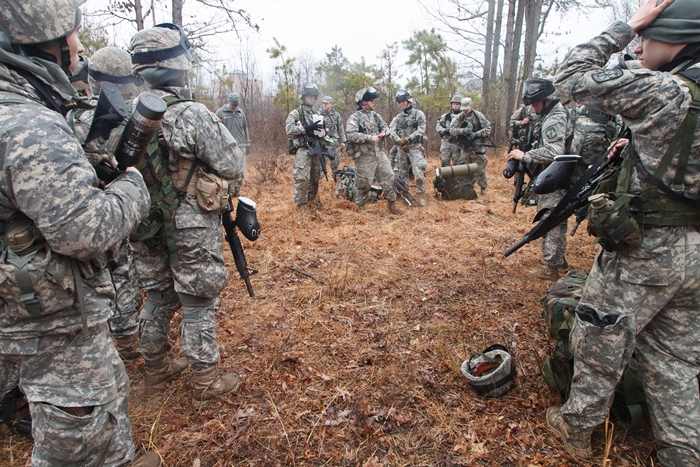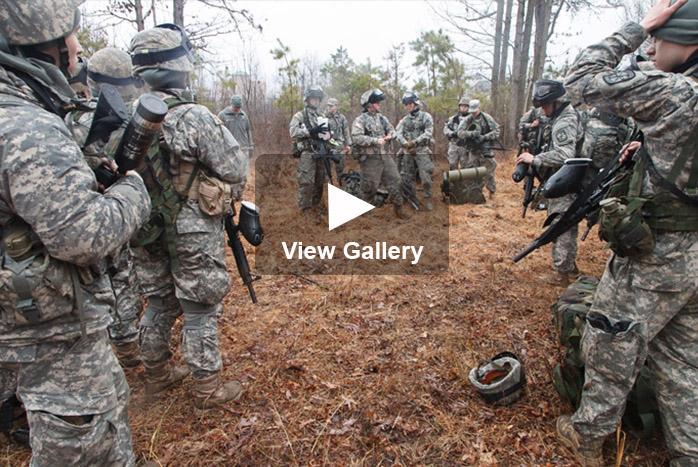Controlling Chaos

Photo by Carl Socolow '77
For Dickinson ROTC students, leadership is all about learning how to think
by Tony Moore, video by Joe O'Neill, photos by Carl Socolow '77
Sixty-seven Army cadets run through iron-gray woods dressed in fatigues and carrying weapons. They need to find their way to the village, where local leaders await and possible insurgents covertly surveil them. Someone yells, “Incoming!” and the group collectively hits the dirt as a puff of smoke pops in the distance.
It all looks real, but the local leaders are role-playing friends and classmates, the weapons are M4 paintball guns and the insurgents are members of Dickinson’s paintball team. So instead of a full-on military operation, what’s transpiring in these Pennsylvania woods is part of an annual leadership training exercise carried out by the Dickinson Reserve Officers Training Corps (ROTC), known locally as the Blue Mountain Battalion.
Here’s the mission in a nutshell: The cadets—from Dickinson and a few other local colleges—find and enter a manufactured village after being told that 80 percent of the people there are friendly and 20 percent are hostile. They must identify the hostiles and the allies, conduct a “key leadership engagement” with imams, police officers and others, and react to the actions taken by the insurgents, who lurk everywhere, from rooftops to sewers.
This isn't exactly the typical college experience, but what these cadets are learning goes hand in hand with what they learn as Dickinson students.
Unpredictable environment
“Really, this is a problem-solving exercise,” says Lieutenant Colonel Paul Culberson, professor of military science and chair of Dickinson’s ROTC program, which oversees all 62 cadets, not just the 30 from Dickinson. “It's controlled chaos: We put them in stressful situations, throw them in with individuals they might not be familiar with and give them a problem and some time to solve that problem, and they have to communicate a plan effectively and execute it.”
These things will likely sound familiar to every Dickinson student, and as Culberson says, what the ROTC program instills in students prepares them well for what awaits upon graduation.
“A lot of Fortune 500 companies look for members of the military, because we’re able to think critically, communicate effectively and solve problems,” he says. “What corporation doesn’t want someone who can solve complex problems in an environment that’s often unpredictable?”
And “unpredictable” is the word of the day with these exercises, which find 15 seniors overseeing the training of 52 younger cadets while wrangling more than 20 volunteers.
“We had at least four teams, and we had to move them around the whole time,” says Jordan Peters '14, one of the seniors running the exercise. “We had to make sure everything stuck to the timeline and the key leaders stuck to their scripts. There were a lot of moving parts, but it worked out really well.”
Thinking, acting
Culberson says that it’s the planning more than the plan itself that breeds success. That planning comes from a foundation of discipline and independent thinking, a combination that might seem contradictory at first glance. But he says that it is just this combination that makes cadets coming out of ROTC such strong leaders.
“In the military, you have to follow orders, have discipline, have set standards,” he says. “While you want independent thinkers, you can’t have everyone acting independently. But when you bring the team together, everyone has a view about how to solve the problem at hand, and you bring those views together and come up with the best plan to accomplish your goals.”
Although he’s still a student and cadet, Peters comes at the mission from a leadership position as well now. And what both he and Culberson see in these missions are lessons also learned in Dickinson classrooms and abroad every day.
“What do you do when you’re facing a person who has a completely different life from you and a completely different upbringing, but you’re trying to accomplish the same thing?” Peters says. “You’re trying to hear what they’re saying, you’re trying to tell them what you can do and what you can’t do, and it’s very tricky. We have to get cadets thinking critically."
The backbone of leadership
This critical thinking forms the intellectual backbone of an effective leader in the military (as Culberson says, “We teach cadets how to think, not what to think”), and it also tends to define Dickinson students.
“Dickinson teaches students to think independently—and globally but while acting locally,” Culberson says. “It’s no different than the strategic corporal in the military: You have to understand what your one action in the middle of Afghanistan, in Iraq, has on the bigger picture.”
For Peters, the day’s training exercise was just one more part of the ROTC adventure.
“ROTC has given me experiences that I probably never would have had otherwise,” Peters says. “I’ve gone to Korea, I’ve gone to the Marshall Islands, I’ve gone repelling out of helicopters. I’ve done all these things that, growing up in a small town, you would have never thought I’d do. A lot of things I’ve been able to do, my friends at other schools, as just regular college students, haven’t been able to do. It’s been great for me.”
Learn more
- Read more about Jordan Peters in his Student Snapshot
- Dickinson’s Department of Military Science
- Dickinson's ROTC history
Published April 10, 2014
